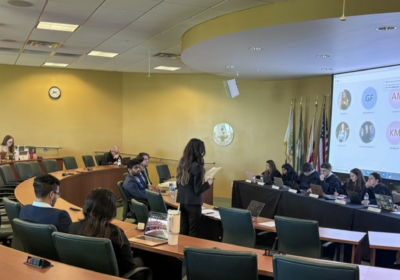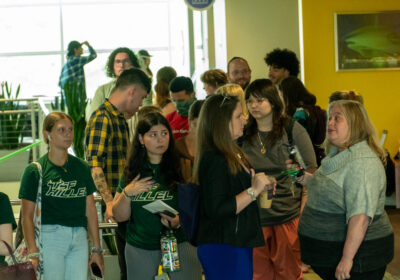Taking online classes this summer? Here are the fees you’ll likely be paying

The USF administration has created a proposal to “rebalance” the fees that students will pay this summer in light of the changing circumstances caused by COVID-19.
For undergraduate students attending USF’s Tampa campus, seven fees are being proposed for reduction or complete omission for the summer 2020 semesters.
The reductions include the Flat Student Union Fee, Facilities Fee, Green Energy Fund Fee, Transportation Fee, Activities and Service (A&S) Fee, Athletic Fee and Capital Improvement Trust Fund.
All reductions in the proposal are per credit hour.
The A&S Fee and Capital Improvement Trust Fund are only being partially reduced in the proposal, with the A&S Fee going from $12.08 to $10.58 and the Capital Improvement Trust Fund from $6.76 to $4.76
Normally, the Flat Student Union Fee is $3.33, the Facilities Fee is $1.50, the Green Energy Fund Fee is $1, the Transportation Fee is $3 and the Athletic Fee is $14.46. However, with the new fee proposal, these have all been reduced to zero.
The Distance Learning Fee that is charged with online classes will be added to all summer courses due to the transition to remote delivery for A, B and C sessions.
But the Distance Learning Fee will be charged at a rate lower than normal during the summer, dropping to $26.79 per credit hour.
“It’s a partial fee,” said USF Provost Ralph Wilcox. “Usually, the distance learning fee is $30 per credit hour.”
The decision to implement the proposed summer fee schedule will be made by the USF Board of Trustees (BOT) on May 7.
“[The proposed fee changes] comes as a recommendation from an ad hoc committee on student fees that I convened late last month,” said Wilcox.
The ad hoc committee was led by Dean Moez Limayem of the Muma College of Business and made up of USF undergraduate and graduate students, faculty, staff and administration from the three USF campuses — Tampa, St. Petersburg and Sarasota-Manatee.
“I asked [the committee] to consider all fees and to prepare a plan that would avoid any increases in fees to students in the summer of 2020, and to maximize our confidence in continuing student success as all of those student support services have been forced to move online,” said Wilcox.
The choice of fee reductions was made so “students will only pay fees for services to which they have immediate and direct access during this summer,” according to the USF Coronavirus Student FAQ website.
Activity and Service Fee
One fee that has recently become a hot topic on the USF Facebook class group chats is the Activity and Service Fee.
A&S fees are used to fund activities like student organizations and sports clubs, as well as other USF departments that provide services and opportunities for students such as the Center for Leadership and Civic Engagement (CLCE), Center for Student Involvement (CSI), New Student Connections (NSC), Recreation and Wellness, and the Marshall Student Center (MSC).
“I know there is some consternation or question about why A&S fees are being reduced,” said Wilcox. “But not perhaps, in the minds of some, being reduced as much as they would like to see.”
As the proposal stands, A&S fees for summer 2020 would be reduced by $1.50, going from $12.08 per credit hour to $10.58 per credit hour. However, the additional flat fee of $7 students pay was not included or altered in the fee change proposal.
The decrease in A&S funding is intended to target services that students would not be able to access due to the remote learning environment.
A&S fees also fund the payroll for many professional and student employees in the Student Success division, including those in CLCE, CSI, the MSC and the Office of Multicultural Affairs (OMA).
Student Government (SG) employees are also paid through A&S fees.
“The committee also determined that any further reduction [to A&S fees] would have an impact on the employment and the salaries of full-time Student Success employees and Student Government employees,” said Wilcox.
The ad hoc committee refrained from reducing the A&S fees past $1.50 because it would lead to possible furloughs or unemployment of Student Success and SG employees, according to Wilcox.
“I fully understood that dilemma and concurred with their [the committee’s] recommendation,” said Wilcox.
Capital Improvement Trust Fund
The other fee that has only been partially reduced is the Capital Improvement Trust Fund, which pays for projects on student facilities that are not funded by state tax dollars.
“The Capital Improvement Trust Fund represents a reduction that the committee felt would have no immediate or significant impact on the students or on the university this summer,” said Wilcox.
Other fees are more cut and dry in the reasoning behind their proposed reduction — the operations and facilities that they fund are expected to be closed through the summer and can’t offer their services remotely.
Flat Student Union Fee and Facilities Fee
One student service that has had to shut down completely is the Marshall Student Center.
It is expected to be closed for the summer semesters, though there is a remote chance it could open during Summer B. The ad hoc committee proposed that the Flat Student Union Fee be completely omitted from $3.33 per credit hour to zero per credit hour.
The Facilities Fee also helps fund the MSC, so the ad hoc committee proposed that it be reduced from $1.50 per credit hour to zero.
“Those two fees [the Flat Student Union and Facilities Fees] would be paused for the summer because we don’t expect the Marshall Student Center to open for student activities during the summer,” said Wilcox.
“There is a possibility that [the Marshall Student Center] might reopen in Summer B, but if it does, students would have access without paying that fee, and that would be just fine.”
Transportation Access Fee
Three other fees have also been completely zeroed out in the university’s proposal as the operations they fund will be halted or limited due to campus closure and recommendations from the Centers for Disease Control (CDC) — the Transportation Access, Athletic and Student Green Energy fees.
“Even with the proposed reduction, USF will continue to provide Bull Runner service, albeit on a reduced schedule,” said Wilcox on the $3 to zero reduction in the Transportation Access Fee.
Athletic Fee
The Athletic Fee is one of the highest students pay. However, with no sports on campus this summer, the proposal reduced it from $14.46 per credit hour to zero.
“It would mean a reduction of services or access to athletic events throughout the summer because we don’t expect softball, baseball or any of the late spring-summer sports to be actively participatory,” said Wilcox.
Student Green Energy Fee
The last fee reduced to zero was the Student Green Energy Fee, which originally stood at $1 per credit hour.
“The green energy fee, likewise, we felt that pausing that fee would have no significant impact in the short term,” said Wilcox.
All of the proposed changes still must be approved by the BOT.
For Wilcox, these changes are crucial to properly and fully transition summer courses to remote instruction.
“The price tag for [converting courses online] is massive,” said Wilcox. “Even the proposed distance learning fees that we are recommending we assess this summer will not cover that cost. It won’t come anywhere close to covering that cost, but it will help.”






